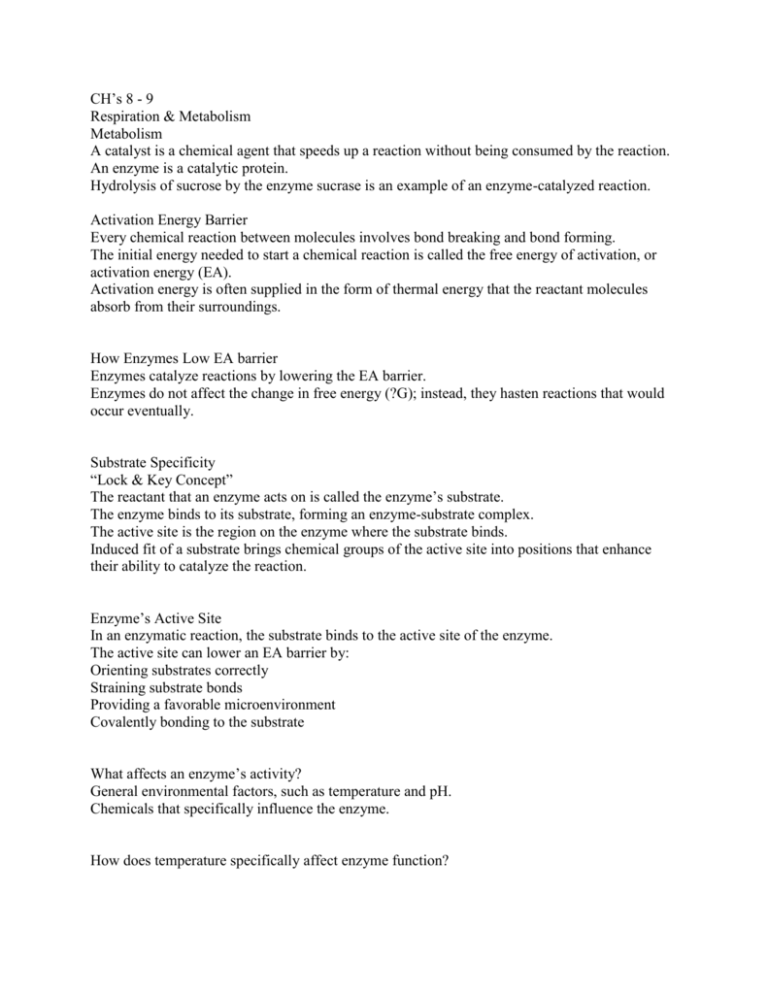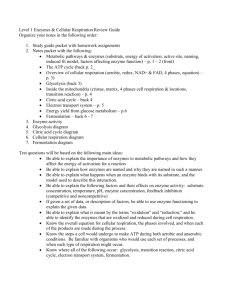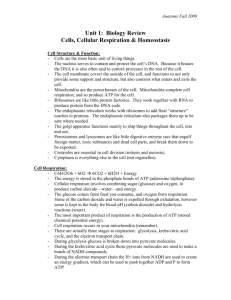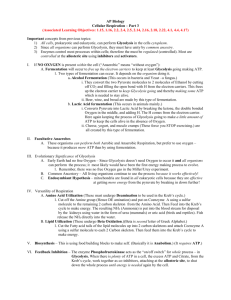Chs 8-9 Notes - FacStaff Home Page for CBU
advertisement

CH’s 8 - 9 Respiration & Metabolism Metabolism A catalyst is a chemical agent that speeds up a reaction without being consumed by the reaction. An enzyme is a catalytic protein. Hydrolysis of sucrose by the enzyme sucrase is an example of an enzyme-catalyzed reaction. Activation Energy Barrier Every chemical reaction between molecules involves bond breaking and bond forming. The initial energy needed to start a chemical reaction is called the free energy of activation, or activation energy (EA). Activation energy is often supplied in the form of thermal energy that the reactant molecules absorb from their surroundings. How Enzymes Low EA barrier Enzymes catalyze reactions by lowering the EA barrier. Enzymes do not affect the change in free energy (?G); instead, they hasten reactions that would occur eventually. Substrate Specificity “Lock & Key Concept” The reactant that an enzyme acts on is called the enzyme’s substrate. The enzyme binds to its substrate, forming an enzyme-substrate complex. The active site is the region on the enzyme where the substrate binds. Induced fit of a substrate brings chemical groups of the active site into positions that enhance their ability to catalyze the reaction. Enzyme’s Active Site In an enzymatic reaction, the substrate binds to the active site of the enzyme. The active site can lower an EA barrier by: Orienting substrates correctly Straining substrate bonds Providing a favorable microenvironment Covalently bonding to the substrate What affects an enzyme’s activity? General environmental factors, such as temperature and pH. Chemicals that specifically influence the enzyme. How does temperature specifically affect enzyme function? Think movement of particles What about pH? Think about acidity & denaturation Cofactors Cofactors are nonprotein enzyme helpers. Cofactors may be inorganic (such as a metal in ionic form) or organic. An organic cofactor is called a coenzyme. Coenzymes include vitamins. Inhibitors Competitive inhibitors bind to the active site of an enzyme, competing with the substrate. Noncompetitive inhibitors bind to another part of an enzyme, causing the enzyme to change shape and making the active site less effective. Examples of inhibitors include toxins, poisons, pesticides, and antibiotics. Allosteric Regulation Allosteric regulation may either inhibit or stimulate an enzyme’s activity. Allosteric regulation occurs when a regulatory molecule binds to a protein at one site and affects the protein’s function at another site. Most allosterically regulated enzymes are made from polypeptide subunits. Each enzyme has active and inactive forms The binding of an activator stabilizes the active form of the enzyme. The binding of an inhibitor stabilizes the inactive form of the enzyme. Feedbacks In feedback inhibition, the end product of a metabolic pathway shuts down the pathway. Feedback inhibition prevents a cell from wasting chemical resources by synthesizing more product than is needed. Brief Review Two ways to regulate an enzyme’s activity? Phosphorylation Allosteric Enzymes Respiration CH 9 Catabolic Pathways & ATP production The breakdown of organic molecules is exergonic. Fermentation is a partial degradation of sugars that occurs without O2. Aerobic respiration consumes organic molecules and O2 and yields ATP. Anaerobic respiration is similar to aerobic respiration but consumes compounds other than O2. Cellular respiration includes both aerobic and anaerobic respiration but is often used to refer to aerobic respiration. Although carbohydrates, fats, and proteins are all consumed as fuel, it is helpful to trace cellular respiration with the sugar glucose: C6H12O6 + 6 O2 ? 6 CO2 + 6 H2O + Energy (ATP + heat) Redox Chemical reactions that transfer electrons between reactants are called oxidation-reduction reactions, or redox reactions. In oxidation, a substance loses electrons, or is oxidized. In reduction, a substance gains electrons, or is reduced (the amount of positive charge is reduced). The electron donor is called the reducing agent. The electron receptor is called the oxidizing agent. Some redox reactions do not transfer electrons but change the electron sharing in covalent bonds. An example is the reaction between methane and O2. Stages of Cellular Respiration Harvesting of energy from glucose has three stages: 1. Glycolysis (breaks down glucose into two molecules of pyruvate). 2. The citric acid cycle (completes the breakdown of glucose). 3. Oxidative phosphorylation (accounts for most of the ATP synthesis). Oxidative phosphorylation accounts for almost 90% of the ATP generated by cellular respiration. A smaller amount of ATP is formed in glycolysis and the citric acid cycle by substrate-level phosphorylation. For each molecule of glucose degraded to CO2 and water by respiration, the cell makes up to 32 molecules of ATP. Glucose Pyruvate Glycolysis (“splitting of sugar”) breaks down glucose into two molecules of pyruvate. Glycolysis occurs in the cytoplasm and has two major phases: Energy investment phase Energy payoff phase Glycolysis occurs whether or not O2 is present. Citric Acid Cycle In the presence of O2, pyruvate enters the mitochondrion (in eukaryotic cells) where the oxidation of glucose is completed. Before the citric acid cycle can begin, pyruvate must be converted to acetyl Coenzyme A (acetyl CoA), which links glycolysis to the citric acid cycle. This step is carried out by a multienzyme complex that catalyses three reactions. The citric acid cycle, also called the Krebs cycle, completes the break down of pyrvate to CO2. The cycle oxidizes organic fuel derived from pyruvate, generating 1 ATP, 3 NADH, and 1 FADH2 per turn. 8 Steps Following glycolysis and the citric acid cycle, NADH and FADH2 account for most of the energy extracted from food. These two electron carriers donate electrons to the electron transport chain, which powers ATP synthesis via oxidative phosphorylation. Electron Transport Chain The electron transport chain is in the inner membrane (cristae) of the mitochondrion. Most of the chain’s components are proteins, which exist in multiprotein complexes. The carriers alternate reduced and oxidized states as they accept and donate electrons. Electrons drop in free energy as they go down the chain and are finally passed to O2, forming H2O. The electron transport chain generates no ATP directly. It breaks the large free-energy drop from food to O2 into smaller steps that release energy in manageable amounts. Chemiosmosis Electron transfer in the electron transport chain causes proteins to pump H+ from the mitochondrial matrix to the intermembrane space. H+ then moves back across the membrane, passing through the proton, ATP synthase. ATP synthase uses the exergonic flow of H+ to drive phosphorylation of ATP. This is an example of chemiosmosis, the use of energy in a H+ gradient to drive cellular work. ATP Production by Cellular Respiration During cellular respiration, most energy flows in this sequence: glucose ? NADH ?? electron transport chain ? proton-motive force ? ATP About 34% of the energy in a glucose molecule is transferred to ATP during cellular respiration, making about 32 ATP. There are several reasons why the number of ATP is not known exactly. Know these numbers Fermentation & Anaerobic Respiration Most cellular respiration requires O2 to produce ATP. Without O2, the electron transport chain will cease to operate. In that case, glycolysis couples with fermentation or anaerobic respiration to produce ATP. Fermentation Fermentation consists of glycolysis plus reactions that regenerate NAD+, which can be reused by glycolysis. Two common types are alcohol fermentation and lactic acid fermentation. In alcohol fermentation, pyruvate is converted to ethanol in two steps, with the first releasing CO2. Alcohol fermentation by yeast is used in brewing, winemaking, and baking. Lactic Acid Fermentation In lactic acid fermentation, pyruvate is reduced to NADH, forming lactate as an end product, with no release of CO2. Lactic acid fermentation by some fungi and bacteria is used to make cheese and yogurt. Human muscle cells use lactic acid fermentation to generate ATP when O2 is scarce. Regulation of Respiration Feedback inhibition is the most common mechanism for control. If ATP concentration begins to drop, respiration speeds up; when there is plenty of ATP, respiration slows down. Control of catabolism is based mainly on regulating the activity of enzymes at strategic points in the catabolic pathway. REVIEW Comparing Fermentation to Anaerobic and Aerobic Respiration All use glycolysis (net ATP =2) to oxidize glucose and harvest chemical energy of food. In all three, NAD+ is the oxidizing agent that accepts electrons during glycolysis. The processes have different final electron acceptors: an organic molecule (such as pyruvate or acetaldehyde) in fermentation and O2 in cellular respiration. Cellular respiration produces 32 ATP per glucose molecule; fermentation produces 2 ATP per glucose molecule.








